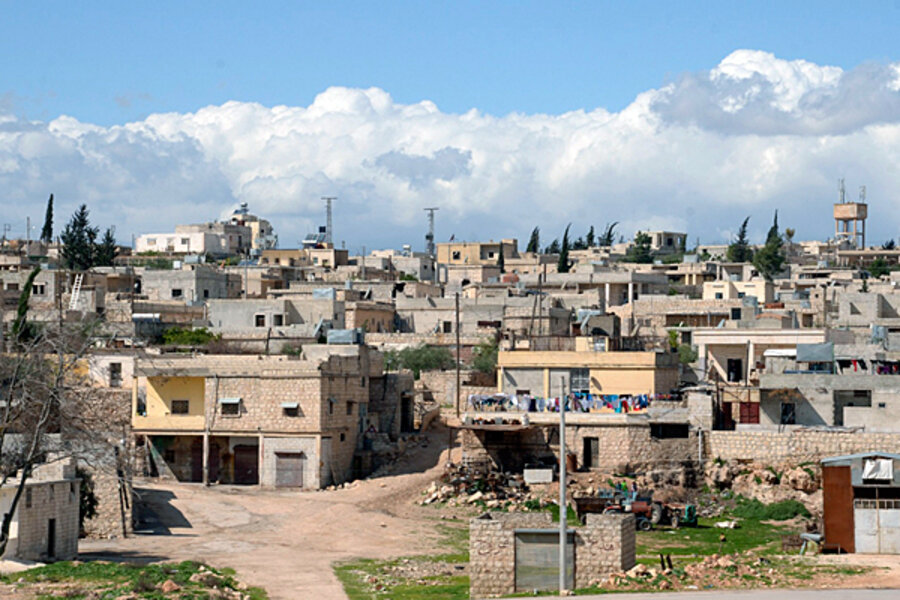Israel charges Syria with lethal chemical weapons use
Loading...
• A daily summary of global reports on security issues.
A senior Israeli military intelligence analyst said today that the military has evidence that the Syrian regime used lethal chemical weapons in a much-scrutinized March attack – the most decisive ruling on those events yet.
The Associated Press notes that this is the first time Israel has made such accusations against the Syrian regime. Western officials seem to widely believe that chemical agents of some kind were used in a March 19 attack, but are at odds over what type.
Amid the flurry of initial accusations – regime and rebel forces each alleged that the other had used chemical weapons – experts told The Christian Science Monitor there was no early evidence that lethal chemical weapons agents were used and that the attack bore signs of nothing more toxic than "a riot-control agent designed to cause irritation."
“In the end, all I can say with confidence is that whatever the conventional or non-conventional munition was, it was not a CW [Chemical Weapons] agent as defined by the CWC [Chemical Weapons Convention],” said Charles Blair, senior fellow for state and non-state threats at the Washington-based Federation of American Scientists, at the time.
But governments have continued to pursue the issue, amassing evidence to make a case that the Assad regime used such weapons, violating international law.
Last week Britain and France sent a confidential letter (subsequently leaked) to United Nations Secretary General Ban ki-Moon asserting that they had proof that the Syrian regime had used chemical weapons in around Aleppo, Homs, and possibly Damascus, The New York Times reports.
Brigadier-General Itai Brun, who is head of military intelligence research for the Israeli Defense Forces, said Israeli evidence – including photographs taken of the area after the attacks – indicated sarin gas, a deadly agent that killed 13 in the Tokyo subway system in 1995, as well as a second agent, "a retardant of some kind," Israeli newspaper Haaretz notes.
"To the best of our professional understanding, the regime used lethal chemical weapons against the militants in a series of incidents over the past months, including the relatively famous incident of March 19," he said, according to AP. "Shrunken pupils, foaming at the mouth and other signs indicate, in our view, that lethal chemical weapons were used."
The Israeli assessment goes further than intelligence from other countries, including the US, which have resisted making conclusions about the type of chemical used in the March 19 attack near Damascus. In fact, some maintain that the agent may not have been lethal, according to Haaretz.
That camp includes experts interviewed by the Monitor and conclusions drawn from interviews with Syrian refugees and rebel fighters:
Syrian television showed crowded hospital scenes with dozens of people being treated for apparent respiratory problems. But the footage of the victims and the lack of pictures from the scene of the blast itself undermined the mutually-traded accusations of a chemical weapons attack.
“I am not convinced that the footage and pictures I have seen prove a CW attack,” wrote Jean Pascal Zanders, a senior research fellow at the Paris-based European Union Institute for Security Studies, on the Arms Control Law blog. “There are no images of the site of the attack; just of some affected people. These people do not show outward symptoms of a CW attack. Definitely not mustard; definitely not a nerve agent.”
The Monitor has heard similar unproven allegations from Syrian refugees and rebel fighters of a paralyzing agent being used near Qusayr, a rebel-held town five miles north of the border with Lebanon. During a nighttime battle in mid-January in Jusiyah, a village south of Qusayr on the border with Lebanon, rebel fighters were allegedly incapacitated by a smoke from a bomb they believe was dropped by a passing jet. Fighters who came to the assistance of their comrades said they found men lying “paralyzed” on the ground, some choking and most unable to speak.
The New York Times reports that the Israeli conclusion has "potentially broad-reaching implications" for the US role in Syria. President Barack Obama said last month in Israel that the Assad regime's use of chemical weapons would be a "game changer," but the US has appeared reluctant to delve deeper into the growing body of intelligence pointing to chemical weapons use.
If American officials have been more reluctant that their allies to come to firm conclusions, it may be because it would force Mr. Obama’s hand. In August, the president told reporters that any evidence that Mr. Assad was moving the weapons or making use of them could prompt the United States to act.
“That would change my calculus,” he said. “That would change my equation.”
But when strong evidence emerged earlier this year that Mr. Assad’s forces were in fact moving their weapons -- at least from one depot to another -- the White House insisted that the action did not cross the line that Mr. Obama set. By “move'’ the weapons, a White House spokesman said, Mr. Obama meant transferring them to a terror group, like Hezbollah. He said there was no evidence of that.
According to The New York Times, the US has plans for taking control of such weapons, but would rather neighboring countries take charge. "But if the weapons were actually used, as three American allies now contend, it would be far more difficult for Mr. Obama to argue that his 'red line' has not been crossed," the paper wrote.
There is little pressure on Israel to intervene in Syria and it has little interest in taking sides in a war in a country with whom it has had a cold, but stable, relationship for 40 years. But Israel is concerned about where advanced weapons, including chemical ones, might end up amid the chaos – specifically in the hands of Lebanese Shiite militant group Hezbollah, an Assad ally, or Islamist extremists fighting alongside the Syrian opposition.
The Christian Science Monitor reported shortly after the March attack that there are at least four sites where chemical weapons are suspected of being manufactured, as well as 50 or more storage facilities. The regime is believed to have moved some of the weapons to more secure storage facilities in areas with strong regime control.








